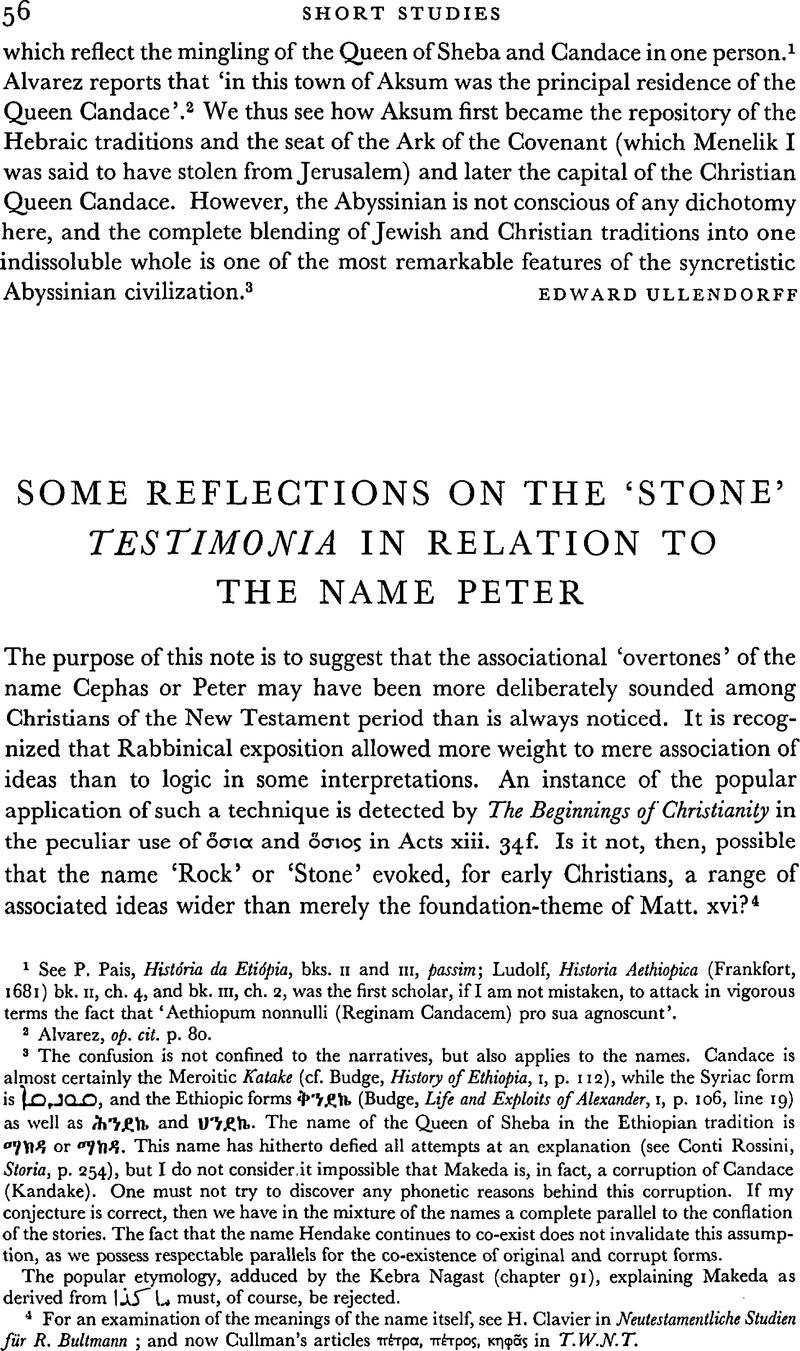Article contents
Some Reflections on the Stone Testimonia in relation to the Name Peter
Published online by Cambridge University Press: 05 February 2009
Abstract

Information
- Type
- Short Studies
- Information
- Copyright
- Copyright Cambridge University Press 1955
References
page 56 note 1 See P. Pais, Histria da Etipia, bks. II and III, passim; Ludolf, Historia Aethiopica (Frankfort, 1681) bk. II, ch. 4, and bk. III, ch. 2, was the first scholar, if I am not mistaken, to attack in vigorous terms the fact that Aethiopum nonnulli (Reginam Candacem) pro sua agnoscunt.
page 56 note 2 Alvarez, op. cit. p. 80.
page 56 note 3 The confusion is not confined to the narratives, but also applies to the names. Candace is almost certainly the Meroitic Katake (cf. Budge, History of Ethiopia, I, p. 112), while the Syriac form is ![]() , and the Ethiopic forms
, and the Ethiopic forms ![]() . (Budge, Life and Exploits of Alexander, I, p. 106, line 19) as well as
. (Budge, Life and Exploits of Alexander, I, p. 106, line 19) as well as ![]() and
and ![]() . The name of the Queen of Sheba in the Ethiopian tradition is
. The name of the Queen of Sheba in the Ethiopian tradition is ![]() , or
, or ![]() . This name has hitherto defied all attempts at an explanation (see Conti Rossini, Storia, p. 254), but I do not consider, it impossible that Makeda is, in fact, a corruption of Candace (Kandake). One must not try to discover any phonetic reasons behind this corruption. If my conjecture is correct, then we have in the mixture of the names a complete parallel to the conflation of the stories. The fact that the name Hendake continues to co-exist does not invalidate this assumption, as we possess respectable parallels for the co-existence of original and corrupt forms.
. This name has hitherto defied all attempts at an explanation (see Conti Rossini, Storia, p. 254), but I do not consider, it impossible that Makeda is, in fact, a corruption of Candace (Kandake). One must not try to discover any phonetic reasons behind this corruption. If my conjecture is correct, then we have in the mixture of the names a complete parallel to the conflation of the stories. The fact that the name Hendake continues to co-exist does not invalidate this assumption, as we possess respectable parallels for the co-existence of original and corrupt forms.
The popular etymology, adduced by the Kebra Nagast (chapter 91), explaining Makeda as derived from ![]() must, of course, be rejected.
must, of course, be rejected.
page 56 note 4 For an examination of the meanings of the name itself, see H. Clavier in Neutestamentliche Studien fr R. Bultmann; and now Cullman' articles ![]() in T.W.N.T.
in T.W.N.T.
page 57 note 1 See, for example, C. H. Dodd, According to the Scriptures (Nisbet, 1952).
page 57 note 2 Cf. op. cit. p. 65.
page 57 note 3 May it be that the parable of the two foundations, Matt. vii. 247, Luke vi. 479, are to be consciously related to this Old Testament theme?
page 58 note 1 For the meaning of this and other names, see M.Noth, Die Israelitischen Personennamen im Rahmen der Gemeinsemitischen Namengebung (Stuttgart, 1928).
page 58 note 2 This was written before I read Dr Paul Winter's interesting article in New Testament Studies, vol. I, no. 2. P. 120 is especially relevant.
page 58 note 3 See M. Noth, op. cit. s.v.
page 59 note 1 This note was written before I had read ch. Ix of Dr Austin Farrer's St Matthew and St Mark, where another continuation is suggested, although with a different intention.
- 2
- Cited by

